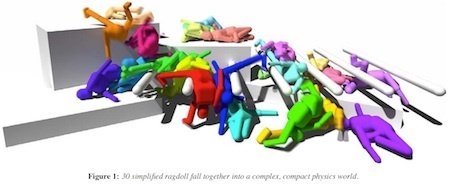Marc Abrahams's Blog, page 357
December 17, 2014
Bird-feather counters exhibited pluck, tediously

Feathers, on a hat on a person, circa 1910. Photo: Library of Congress.
Many humans have spent days, months or years counting feathers. Here are exciting highlights from some of their reports.
In 1936 Alexander Wetmore, of the US National Museum in Washington, gathered all the published reports he could find about someone or other counting how many feathers were on particular birds. “The work of feather counting is tedious and exacting,” he explained, “and yields small result relative to the labour involved.”
Among Wetmore’s gatherings from his peers: “Dr Jonathan Dwight found 3,235 feathers on a male Bobolink taken in spring. RC McGregor has recorded 1,899 feathers on a Savannah sparrow … and 6,544 on a glaucous winged Gull … Miss Phoebe Knappen has reported 11,903 feathers on an adult female mallard … the bird being one that had died from phosphorus poisoning.”
Wetmore proceeded to have someone he could count on do some do some new counting on his behalf: “The actual labour of counting was done under my direct supervision by Marie Siebrecht (now Mrs James Montroy) who, employed as an assistant, worked carefully and conscientiously at a long and somewhat tedious task”….
—So begins another Improbable Research column in The Guardian.
December 16, 2014
Multiplicity of Authors: Quisquaters and Guillous
This entry in our Multiplicity of Authors collection features several Quisiquaters and several Guillous:
“How to Explain Zero-Knowledge Protocols to Your Children,” Jean-Jacques Quisquater [pictured here], Myriam Quisquater, Muriel Quisquater, Michaël Quisquater, Louis C. Guillou, Marie Annick Guillou, Gaïd Guillou, Anna Guillou, Gwenolé Guillou, Soazig Guillou, Thomas A. Berson, Proceedings of the 9th Annual International Cryptology Conference, Santa Barbara, California, USA, August 20-24, 1989, pp. 628-631.
(Thanks to Jean-Jacques Quisquater for bringing this to our attention.)
December 15, 2014
Tax demands – the funny side (he makes ‘em LAUGH, then PAY)
John Morreall (pronounced Mor-el), is not only professor of religion and department chair at the College of William and Mary, Williamsburg, Virginia, US, he also runs Humorworks, which, amongst other things, conducts corporate seminars on the subject of humor, with clients such as the Internal Revenue Service, The World Bank, and Ernst & Young.
Thus he investigates the possibilities for things that make people LAUGH and then PAY. Here’s a suggestion regarding IRS tax-demands :
“If you can get people to laugh, and realize that they owe you money, and pay up [that’s] much more successful.”
BONUS: Some say the human condition is a tragedy, others say it’s a comedy – or perhaps a comic tragedy, or maybe a tragicomedy. In either, all, or no cases, the professor presents a paper for the April 2014 edition of the British Journal of Aesthetics, (Volume 54, Issue 2) entitled : The Comic Vision of Life.
“Tragedy has traditionally been ranked higher than comedy, and critics often valorize the ‘tragic vision of life’. Using twenty contrasts between tragedy and comedy, I argue that there is a ‘comic vision of life’ which is superior to the tragic vision, especially in the post-heroic era in which we live.”
December 14, 2014
Lots and lots of bits of copying in scientific literature
A new study indicates that lots of bits of old studies turn up, verbatim, in lots of newer scientific studies. The new study (which I have not checked to see whether it contains uncredited copied text) is:
“Patterns of text reuse in a scientific corpus,” Daniel T. Citron and Paul Ginsparg [pictured here], Proceedings of the National Academy of Sciences, epub December 8, 2014. The authors at Cornell University, report:
“We consider the incidence of text ‘reuse’ by researchers via a systematic pairwise comparison of the text content of all articles deposited to arXiv.org from 1991 to 2012. We measure the global frequencies of three classes of text reuse and measure how chronic text reuse is distributed among authors in the dataset. We infer a baseline for accepted practice, perhaps surprisingly permissive compared with other societal contexts, and a clearly delineated set of aberrant authors. We find a negative correlation between the amount of reused text in an article and its influence, as measured by subsequent citations.”
Co-author Ginsparg is the creator of arXiv.
John Bohannon gives further details and comment, in Science magazine.
(Thanks to investigator Scott Langill for bringing this to our attention.)
Are shoes good for you?
The Swiss researchers who (some of them) two years ago did an “analysis of a piece of shit” now supply an answer to the question “Are shoes good for you?” They are two-fifths of the way towards completing the poetical list “shoes and shit [reverse sic] and sealing wax, cabbages and kings“.
Their shit study is called “An In-Depth Analysis of a Piece of Shit: Distribution of Schistosoma mansoni and Hookworm Eggs in Human Stool.” Their shoes study is:
“Association between Footwear Use and Neglected Tropical Diseases: A Systematic Review and Meta-Analysis,” Sara Tomczyk, Kebede Deribe, Simon J. Brooker, Hannah Clark, Khizar Rafique, Stefanie Knopp, Jürg Utzinger, Gail Davey, PLOS Neglected Tropical Diseases, 8(11), epub Novembr 13, 2014. e3285. (Thanks to Pratik Dave for bringing this to our attention.) The authors report:
“Consistent use of footwear may help in preventing or slowing down the progression of many neglected tropical diseases (NTDs). We conducted a systematic review and meta-analysis to assess the association between footwear use and infection or disease for those NTDs for which the route of transmission or occurrence may be through the feet. We found that footwear use reduces the risk of Buruli ulcer, tungiasis, hookworm, any STH infection, strongyloidiasis, and leptospirosis. No significant association between footwear use and podoconiosis was found and no data were available for mycetoma, myiasis or snakebite. We recommend that access to footwear should be prioritized alongside existing NTD interventions to ensure a lasting reduction of multiple NTDs and to accelerate their control and elimination.”
Professor Jürg Utzinger [pictured here], a driving force behind both studies, will soon take on new responsibilities:
The Board of Governors of the Swiss Tropical and Public Health Institute (Swiss TPH) has elected Prof. Jürg Utzinger as the new director with effect from 1 July 2015. The vote was unanimous. Prof Utzinger will succeed Prof. Marcel Tanner, who has led the Institute with great success since 1997 and is to stand down after three terms in office on 30 June 2015.
Terrier’s new door-in-the-face technique
Every once in a long while, someone devises a new door-in-the-face technique. It has happened again:
“Door-in-the-Face: Is It Really Necessary That Both Requests Be Made by the Same Requester?” Lohyd Terrier [pictured here], Bénédicte Marfaing, and Marc-Olivier Boldi, Psychological Reports, Volume 113, 2013, pp. 675-682. The authrs, at Ecole Hôtelière de Lausanne and Université de Fribourg, Switzerland, explain:
“The door-in-the-face technique increases the likelihood of individuals accepting a target request by confronting them, beforehand, with an extreme request. The present research tests a new door-in-the-face technique in which the two requests are formulated by two different requesters during the same interaction. 160 participants were asked to help a charity organization following a door-in-the-face procedure. According to the experimental conditions, requests were formulated by one or two requesters during the same or a different interaction. As predicted, the door-in-the-face effect was observed even if two requests are formulated by two requesters, but only if both are present during the interaction.”
Professor Terrier earlier published other studies about door-in-the-face theory and practice:
Sénémeaud, C., Somat, A., Terrier, L., & Noel, Y. (2008). Porte-au-nez et préférence pour la consistance : Quand les sujets à forte préférence pour la consistance ne reproduisent pas les effets de l’influence sociale. L’Année Psychologique, 108, 51-78.
Terrier, L. & Joule, R.V. (2008). La procédure de porte-au-nez : vers une interprétation motivationnelle. Cahiers Internationaux de Psychologie Sociale, 77, 5-14.
Terrier, L., Joule, R.V. & Marfaing, B. (2011). Requester’s acceptance and non-acceptance of the refusal of the initial request: how to improve the door-in-the-face effects?. Current Research in Social Psychology, 17 (1), 1-9.
December 13, 2014
Feynman on the difference between names and what’s going on
Richard Feynman told stories that got people thinking. This passage from a talk Feynman gave at a meeting of the National Science Teachers Association in 1966 in New York City, was later printed — as part of a transcript of the entire talk — in The Physics Teacher, vol. 7, issue 6, 1969, pp. 313-320.
The next day, Monday, we were playing in the fields and this boy said to me, “See that bird standing on the stump there? What’s the name of it?”
I said, “I haven’t got the slightest idea.”
He said, “It’s a brown-throated thrush. Your father doesn’t teach you much about science.”
I smiled to myself, because my father had already taught me that [the name] doesn’t tell me anything about the bird. He taught me “See that bird? It’s a brown-throated thrush, but in Germany it’s called a halsenflugel, and in Chinese they call it a chung ling and even if you know all those names for it, you still know nothing about the bird–you only know something about people; what they call that bird. Now that thrush sings, and teaches its young to fly, and flies so many miles away during the summer across the country, and nobody knows how it finds its way,” and so forth. There is a difference between the name of the thing and what goes on.
The result of this is that I cannot remember anybody’s name, and when people discuss physics with me they often are exasperated when they say “the Fitz-Cronin effect,” and I ask “What is the effect?” and I can’t remember the name.
I would like to say a word or two — may I interrupt my little tale — about words and definitions, because it is necessary to learn the words.
It is not science. That doesn’t mean, just because it is not science, that we don’t have to teach the words. We are not talking about what to teach; we are talking about what science is. It is not science to know how to change Centigrade to Fahrenheit. It’s necessary, but it is not exactly science. In the same sense, if you were discussing what art is, you wouldn’t say art is the knowledge of the fact that a 3-B pencil is softer than a 2-H pencil. It’s a distinct difference. That doesn’t mean an art teacher shouldn’t teach that, or that an artist gets along very well if he doesn’t know that. (Actually, you can find out in a minute by trying it; but that’s a scientific way that art teachers may not think of explaining.) …
December 12, 2014
Behemoth – not hippo nor elephant?
 Those involved in studying biblical texts sometimes disagree about the exact nature of Behemoth, as described in the Bible, in Job 40:15-24. Could it have been, as some have suggested, a description of an elephant, or a(n) hippopotamus? Dr. Dave Miller Ph.D., M.A.R., M.Div., M.A., B.A., writing in the journal Reason & Revelation, Dec. 2011, Vol. 31, No. 12, thinks not, and offers an alternative interpretation :
Those involved in studying biblical texts sometimes disagree about the exact nature of Behemoth, as described in the Bible, in Job 40:15-24. Could it have been, as some have suggested, a description of an elephant, or a(n) hippopotamus? Dr. Dave Miller Ph.D., M.A.R., M.Div., M.A., B.A., writing in the journal Reason & Revelation, Dec. 2011, Vol. 31, No. 12, thinks not, and offers an alternative interpretation :
“In His description of behemoth, God states emphatically that the creature ‘moves his tail like a cedar’ (Job 40:17). Yet many commentators have insisted that behemoth is to be identified as either the elephant, or more likely, the hippopotamus (cf. the NIV footnote at Job 40:15: “Possibly the hippopotamus or the elephant”). Since both of these animals have farcically tiny tails, the comparison of behemoth’s tail with a cedar must be explained in some way.”
The Dr.’s explanation is that Behemoth might have, instead, been a dinosaur – a(n) herbivorous one to comply with Job 40:15. He suggests, Apatosaurus or Argentinosaurus or even Diplodocus. For those who might be unclear about the timing – in the sense that Job would need to have been living at the same time as Behemoth (the dinosaur), Dr. Miller goes on to add :
“The imposing intimidation of modern pseudo-science, that dominates the intellectual landscape of the world, has succeeded in pressuring many to compromise the biblical text in hopes of retaining what they conceive to be academic legitimacy and sophistication. Nevertheless, abundant bona fide evidence exists to demonstrate that dinosaurs were created by God on the same day of Creation as humans (Genesis 1:24-31), that dinosaurs and humans once cohabitated (cf. Lyons and Butt, 2008), and that the incredible creature of Job 40 was, in fact, some kind of dinosaur.”
Further reading:
(as cited in the article) ‘The Dinosaur Delusion’ (Lyons and Butt, 2008)
(not cited in the article) ‘The God Delusion’ (Dawkins, 2008)
Study: Top (male) comedians die earlier?
A new study from professors Simon Stewart and David Thompson of the Centre for the Heart and Mind and the Mary MacKillop Institute of Health Research (MMIHR) at the Australian Catholic University (ACU) has found that :
“Elite comedians are at increased risk of premature death compared to their less funny counterparts.”
The team examined a study cohort of 53 (exclusively male) comedians from the UK and Ireland – both living (23) and not (30) – and analysed the data using IBM SPPS Statistics version 22.0. The data were weighted according to the ‘funniness’ of the man in question, running from ‘relatively funny’ to ‘hilariously funny’.
Results:
“On an adjusted basis, there was no correlation between the decade of birth (HR 0.94, 95% 0.65 to 1.38 per incremental decade; p =0.763) and comedy team status (HR 1.13, 95% 0.51 to 2.48 versus independent comedian; p = 0.761) with longevity. However, an increasingly funny comedy score was associated with increased mortality (HR 1.24, 95% CI 1.06 to 1.44 per unit funny score; p = 0.006). Of the 23 comedians adjudged to be very funny (score 8–10), 18 (78%) had died versus 12 (40%) of the rest; mean age at death 63.3 ± 12.2 versus 72.3 ± 14.7 (p = 0.079). Within comedy teams, those identified as the funnier member(s) of the partnership were, on an adjusted basis, more than three times more likely to die prematurely when compared to their more serious comedy partners (HR 3.52, 95% CI 1.22, 10.1; p = 0.020).”
The hypothesis was further bolstered with the finding that in the case of double-acts, the ‘stooges’ (or straight men) were more than 3 times less likely to die on an adjusted basis before those designated as the funny man.
See: ‘Does comedy kill? A retrospective, longitudinal cohort, nested case–control study of humour and longevity in 53 British comedians’ in: The International Journal of Cardiology, 180 (2015), pp. 258–261.
Notes [1] : The paper cites this study from the British Journal of Psychiatry, 204 (2014), pp. 341–345, by Victoria Ando, Gordon Claridge and Ken Clark Psychotic traits in comedians. The researchers asked more than 500 comedians to complete an online form based on the Oxford-Liverpool Inventory of Feelings and Experiences (O-LIFE), with scales measuring four dimensions of psychotic traits, finding that : “Comedians scored significantly above O-LIFE norms on all four scales.”
[2]: Sadly, both the comedians in the clip above – Peter Cook (comedy rating 9 in the ACU study) and Dudley Moore (comedy rating 5 in the ACU study) are no longer metabolically extant. They are deceased. They are ex-comedians. They do, however, in a sense, live on, in YouTubeLand
December 11, 2014
Rod constraints for simplified ragdolls
Programmers sometimes love rag dolls. This study is the fruit of one such love:
“Rod constraints for simplified ragdolls,” Chris Lewin, Matt Thorman, Tom Waterson, Chris Williams, and Phil Willis, Proceedings of the 12th ACM SIGGRAPH/Eurographics Symposium on Computer Animation, pp. 79-84. ACM, 2013. The authors, at the University of Bath, UK, and Electronic Arts, explain:
“Physics-based animation has become a standard feature in modern games. Typically, the bones in a character’s animation rig are each associated with a simulated rigid body, leading to a jointed assembly commonly called a ragdoll. The high density of animation bones in the spine area can cause instability and performance issues, so we are motivated to find a simplified physical representation for this region. We approximate the spine region of a ragdoll as an inextensible elastic curve, building a circular arc constraint based on the Kirchhoff rod model. Our simplified spine shows improved performance and stability over the standard group of socket joints, and proves to be more controllable.”
Here’s more detail from the study:
Marc Abrahams's Blog
- Marc Abrahams's profile
- 14 followers





